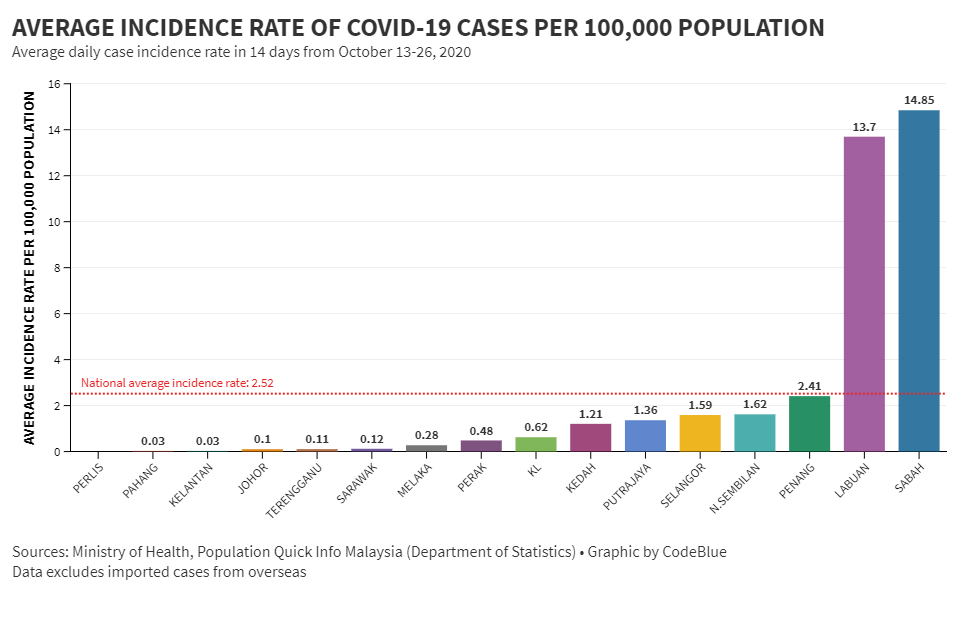KUALA LUMPUR, Oct 27 — Sabah, Malaysia’s current Covid-19 epicentre, had the highest average daily Covid-19 case incidence rate in the country at 14.85 per 100,000 inhabitants over the past two weeks, almost six times higher than the national average.
The next highest average case incidence rate of 13.7 per 100,000 population in Labuan, neighbouring Sabah, exceeded the national average incidence rate of 2.52 per 100,000 inhabitants by over five times. Labuan is an isolated island in Borneo with a total population of 99,600 and is only equipped with a small district hospital.
All other states — including Selangor and the Federal Territories of Kuala Lumpur and Putrajaya that have been placed under a two-week extension of the Conditional Movement Control Order (CMCO) until November 9 — fell below the national average.
Incidence rate is defined as the number of new cases of a disease within a time period to the proportion of the number of people at risk. CodeBlue took the entire estimated population size in each state and Malaysia this year, based on data from the Department of Statistics Malaysia, and the Covid-19 cases reported from October 13 to 26, excluding infections imported from abroad, in this analysis of average daily case incidence rates per 100,000 inhabitants across states and nationwide over the past 14 days.
From October 13 till October 26, the average Covid-19 case incidence rate in Sabah — the second most populous state in the country with an estimated population of 3,908,500 — was 14.85 per 100,000, which means that in every 100,000 people, an average of 14.85 people were infected daily with Covid-19 in the state in the past two weeks. This translates to a daily average of 579 cases state-wide across the 3.9 million population.
The higher the incidence rate, the higher the risk of infection in the population, which means that people in Sabah and Labuan have the highest risk of getting infected with Covid-19 compared to residents in other states in Malaysia.
Sabah has been reporting three-digit Covid-19 cases daily since October 1. Yesterday, Sabah reported its highest tally of 927 cases in just 24 hours. Frontliners on the ground have told CodeBlue that patients need to wait nearly two days to get into the intensive care unit (ICU), hospital beds are full, while doctors on the ground are almost burnt out. But the Ministry of Health (MOH) yesterday disputed claims that Sabah’s health care system was under collapse, insisting that hospital beds were still sufficient.
Selangor came in fifth in the ranking of Covid-19 case incidence rates among all the states in Malaysia at 1.59 per 100,000 population, even lower than the 1.62 average incidence rate in Negeri Sembilan. Selangor is Malaysia’s most populous state with an estimated current population of 6,538,100, while Negeri Sembilan’s estimated population is 1,128,800.
Putrajaya came in sixth after Selangor, followed by Kedah, while Kuala Lumpur came in eighth in position. Putrajaya, with an estimated current population of 110,000 people, had an incidence rate of 1.36 per 100,000 population. Kuala Lumpur’s average incidence rate over the past two weeks was only 0.62.
However, yesterday, Senior Defence Minister Ismail Sabri Yaakob announced that the Klang Valley CMCO, which was initially implemented from October 14 till October 27 in Selangor, Kuala Lumpur, and Putrajaya, would be extended for another two weeks until November 9, on the basis that some locations in the Klang Valley still had high risk of Covid-19 transmission.
Former Health Minister Dzulkefly Ahmad, who is also the head of Selangor’s Covid-19 task force (SFTC), told CodeBlue that lockdowns alone will not be able to cut down virus transmission in the country. He stressed that lockdowns are not an exit to a pandemic, which can only be achieved through the arrival and use of a vaccine or an antiviral treatment.
Among the states in Malaysia, Penang, with an estimated current population of 1,773,600, came in third with an incidence rate of 2.41 per 100,000 inhabitants, but the majority of the cases that have been reported lately were from prisons. For example, on October 25, Penang reported 97 positive Covid-19 cases, and almost 97 per cent (94 cases) were from the Seberang Perai Prison cluster.
The national daily average incidence rate for Covid-19 cases per 100,000 population was 2.52 from October 13 till October 26, while according to CodeBlue’s calculations, the world average incidence rate from October 12 till October 25 was 5.04 per 100,000 population. Malaysia’s current estimated population is 32,657,300, according to the Department of Statistics.
The capital city of Kuala Lumpur and states of Perak, Melaka, Sarawak, Johor, Terengganu, Kelantan and Pahang had an average incidence rate of less than one per 100,000 people, while Perlis had an incidence rate of zero as the country’s smallest state has not been reporting any Covid-19 cases over the last two weeks.








